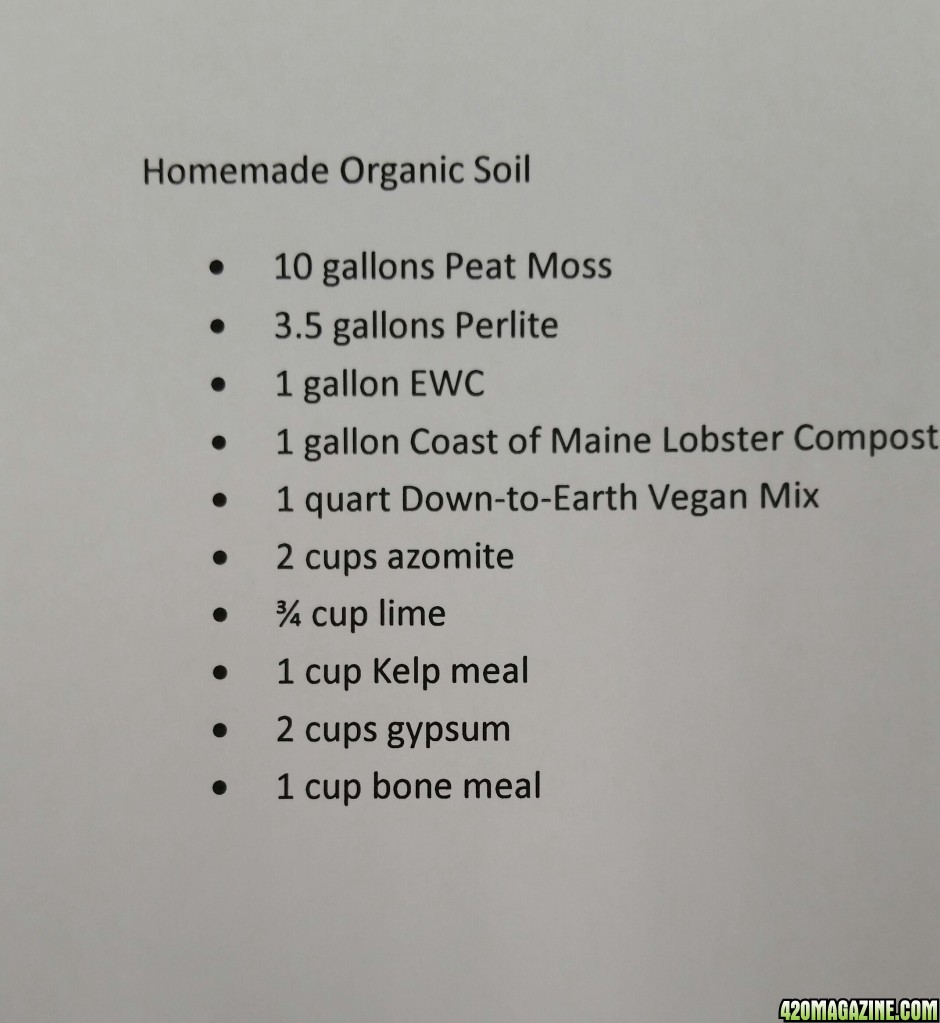Good morning CanEyeBus

If you want to try your hand at organics, you can use one of the many "recipes" found in this thread

there is no "single" perfect mix, they will all work to grow in. Even with the scientific approaches some of us take, when designing our soil, no 2 plants (or strains) are the same and we still have to watch our girls and let them tell us if they are lacking in some nutrient

If you want to take a simpler approach your first run, use Pro-Mix BX or HP as your base, amend it with Epsom salts, blood meal, bone meal and alfalfa meal (quantities will depend on how much you want to mix). The Pro-Mix has Mycos in it making this a simple recipe that will grow your plants.
If you want to get more advanced, start with peat, aloe, lime and Epsom salts for your base. Then custom tailor your amendments according to what is available in your area. There are many of us here who can help you with this

As for storing it, I keep a few totes inside during the winter full of amended soil. It will keep, the nutrients don't disappear until a plant uses them. You can also continually recycle your soil as well. Just re-amend it before the next use, either no-till or using the old soil as your new base. If you keep a lid on the tote and keep it in a cool place the Mycos will survive so long as the soil doesn't dry out.
If you have more questions, or want help designing your first soil, give a shout, we will share what we know and have learned with you




 I'm intrigued by the no till los method. I'm just not brave enough to take the plunge. The thing that somewhat dissuades me is the larger containers needed. I flower in 3 gal containers max. Don't have a plot of land to cook the soil on. I could most likely source all the materials needed locally as I live in a city where agri framing is practiced as well as general. Also, we have a few rock quarries around. Question, to you all, Sweetsue,Roach,bobrown,rad,RobCelt etc.. If I wanted to get my feet wet with organic growing on a small scale, say, 2-3 plants in 2.5 -3 gal containers. How would you approach it? I'd want to try it out a run before committing my entire flower tent to the medium switch. I know it'll be for the betterment of the end product, and my sanity. I want to learn to grow organically and all of it's intricacies and not just copy and repeat. I know I'd be buying more product than needed for such a small plant run, can the un-used soil be stored? If so, for how long and what if anything will be needed to keep the soil's biology active? I'm sure I'll have more ?'s. Bare with me
I'm intrigued by the no till los method. I'm just not brave enough to take the plunge. The thing that somewhat dissuades me is the larger containers needed. I flower in 3 gal containers max. Don't have a plot of land to cook the soil on. I could most likely source all the materials needed locally as I live in a city where agri framing is practiced as well as general. Also, we have a few rock quarries around. Question, to you all, Sweetsue,Roach,bobrown,rad,RobCelt etc.. If I wanted to get my feet wet with organic growing on a small scale, say, 2-3 plants in 2.5 -3 gal containers. How would you approach it? I'd want to try it out a run before committing my entire flower tent to the medium switch. I know it'll be for the betterment of the end product, and my sanity. I want to learn to grow organically and all of it's intricacies and not just copy and repeat. I know I'd be buying more product than needed for such a small plant run, can the un-used soil be stored? If so, for how long and what if anything will be needed to keep the soil's biology active? I'm sure I'll have more ?'s. Bare with me






